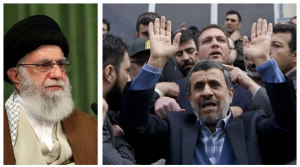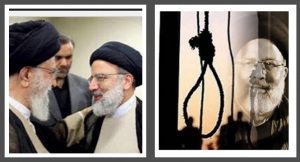(Video) Iran : Khamenei’s Circle and the Complex Power Strain
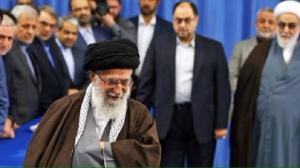
In early 1989, following the death of the Iranian regime’s former Leader, Ruhollah Khomeini, and amid dense consultations, brokering, and deal-making among Khomeini’s inner circle, Ali Khamenei rose to become the new Supreme Leader of the regime in Iran.
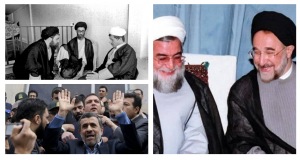
After securing his mandate as Supreme Leader, Khamenei managed to defame, sideline, and eliminate his former allies and potential rivals to cling to power in one of the most important geographic locations and decisive factors of global order.
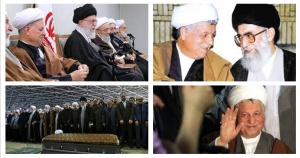
Rafsanjani wanted to pave the way for a law that would enable him to become a presidential candidate for the third time, but Khamenei With an agenda of countering Western sanctions, the fifth Majlis was sworn, and K began to push back on Rafsanjani’s bloc.
In his first four-year tenure, Ahmadinejad was nothing but a yes-man to Khamenei and eyed policies that were in line with the Supreme Leader.
Tremendously unstable and weakened after the cease-fire with Iraq, Khomeini’s successors could not afford to present their demoralized forces with a power void in Tehran.
Nevertheless, after securing his mandate as Supreme Leader, Khamenei managed to defame, sideline, and eliminate his former allies and potential rivals to cling to power in one of the most important geographic locations and decisive factors of global order.
Initially weaker and more junior to then Deputy Commander-in-Chief of the Iranian Armed Forces Akbar Hashemi Rafsanjani, Khamenei made sure to surround himself with a close-knit group of people whose loyalty became crucial in solidifying his own dominance politically, economically as well as militarily.
Khamenei’s Office: The Beyt
The Supreme Leader’s Office, also known as the Beyt [Arabic for the house], is an organization that is managed under the supervision of Ali Khamenei. Generally, this organization is the management center of all organizations, institutions, general offices, non-profit institutions, and other entities that are under the direct supervision of Khamenei and his trustees.
The Office is more of a complex network than an administrative, political, or religious organization. This intricate and interwoven web, which includes special military and security offices and Khamenei’s personal aids, has formed a powerful circle and a first-rate communication and information channel that help the regime’s highest official to steer his regime through existential crises and a convergence of domestic and international threats.
There are at least 15 key figures of this network who have maintained their position despite the ebbs and flows caused by different administrations throughout the years. Mainly from an intelligence or military background, they have exceptional ties with Khamenei and his son Mojtaba.
The Office appoints the head of the regime’s Radio and Television Organization (IRIB), the members of the Guardian Council and the Expediency Council, and the Judiciary Chief.
The Expediency Council, which is supposed to hold sway over disputes between the Executive and the Legislative branches, is a contradictive combination of conflicting interests. Trying to avoid major defections, Khamenei has effectively stacked the Expediency Council with former senior officials who have fallen out of his favor. Their role in this council is supposed to encourage unity among state leaders without giving them any executive role.
Since the new waves of uprisings began in September 2022, Khamenei conducted several public speeches and called for “the elders of the state” to take a stance. However, his repeated calls have fallen on deaf ears ever since.
Ali Asghar Hejazi
Ali Asghar Hejazi is the Deputy of Political-Security Affairs of the Supreme Leader’s Office. He is practically the most influential figure in the regime’s intelligence structure, even superior to the Minister of Intelligence (MOIS) and the Islamic Revolutionary Guards Corps Intelligence Organization (IRGC-IO) Chief.
In April 2011, then-President Mahmoud Ahmadinejad fell out with his own Minister of Intelligence, Heydar Moslehi. The MOIS Chief refused to keep him updated on the latest security-related developments and decisions but kept reporting to Hejazi instead. Following a dispute between Moslehi and Ahmadinejad’s senior advisor Esfandiar Rahim Mashaee, Ahmadinejad attempted to dismiss Heydar Moslehi as Minister of Intelligence. Khamenei promptly overruled the decision, causing a public rift between the two leaders.
This caused the former President to express his displeasure by refusing to attend cabinet meetings or report to his office in the presidential palace for 11 days. The incident revealed the obscure power struggle between a sitting president and Khamenei.
Gholam-Ali Haddad Adel
On June 28, 2008, Gholam-Ali Haddad Adel was elected as the senior advisor to the Supreme Leader. In Khamenei’s ruling for his new position, his “political and cultural background” was mentioned, and his consultations are believed to be limited to both domains.
Mojtaba Khamenei, the second son of Ali Khamenei, is married to Haddad Adel’s daughter. This family connection played an important role in securing Haddad Adel’s position in Khamenei’s inner circle.
Haddad Adel also heads the Coalition Council of Islamic Revolution Forces, which was described as the “biggest hardline group” in the elections and “expected to dominate” the parliament.
Haddad Adel rooted for Raisi to become Khamenei’s favorite candidate in the 2017 presidential election.
Kamal Kharazi
On June 25, 2006, Khamenei appointed Ali-Naghi (Kamal) Kharazi as the head of the Strategic Council of Foreign Relations. The body is a council that was created in 2005 through a Supreme Leader’s directive “to concoct strategies, policies and solutions that will bring the Islamic Republic to the desired results in foreign policy” and “to create greater coordination in all activities in is the field of foreign relations.”
The council has four commissions:
• Political Commission headed by Saeed Jalili
• Economic Commission headed by Ebrahim Sheybani
• Defense-Security Commission headed by Hossein Dehghan
• Scientific-cultural Commission headed by Mehdi Mostafavi
The council reports directly to the Supreme Leader’s Office, and Saeed Jalili is the most senior figure in the organization who has a special place in the Beyt.
On September 20, 2022, Kharazi became a member of the Expediency Council by Khamenei’s decree.
Majlis; Assembly of Gangs
The legislative branch in this regime is rather a court where different factions fight and practice power.
There are no political parties in its true sense. Rather there are rival factions with various leanings who dispute over authority. But there is a ceremonial partisanship that is mainly used during the sham presidential and parliamentary elections.
Every single member of an official political party is vetted by the Guardian Council, who, besides verbal and documented oath of allegiance to the Supreme Leader and the regime’s Constitutions, can only win over their trust merely by practical loyalty, being an accomplice in the regime’s preceding atrocities.
In the first parliament following the post-1979 revolution, ‘Nehzat Azadi’ [the Freedom Movement] under Eng. Mehdi Bazargan was still tolerated. A traditional rightwing faction that called itself the Combatant Clergy Association included senior clerics like Hashemi Rafsanjani and Ali Khamenei.
Another faction that called itself ‘Jaryan-e-Khate-Emam’ [the Movement of Imam’s Political Line] comprised of some radical elements who used to pride themselves on being the most revolutionary party and anti-Westernism.
In the 1980s, they were the fiercest interrogators, torturers, and human rights violators in Iran’s prisons as well as the streets. They also invaded the US embassy in November 1979 and were trusted by then-Supreme Leader Khomeini.
As the founder of the clerical regime, Khomeini used to counterbalance the rivaling factions against each other to hold sway over his reign. In the summer of 1981, he forced the new president Ali Khamenei to accept Mirhossein Mousavi as his Premier Minister, even though he knew Khamenei’s had strong reservations about Mousavi. Mousavi belonged to the rival faction that called itself the Islamic Republican Party.
The second post-revolution parliament, also called Majlis, was dominated by the traditional rightwing faction, while the third was equally distributed between three different political tendencies.
Following Khomeini’s death and Khamenei’s resignation to succeed him as the new Supreme Leader, then-parliament speaker Hashemi Rafsanjani became president. This began a split between the two most powerful rivals that lasted for three decades until it was terminated with Rafsanjani’s death.
In the early 1990s, international isolation, domestic discontent, and economic impasse had turned the once extremist ‘Khat-e-Emam’ faction into a group of revisionists. Claiming to seek reform, some of them called on the regime’s leadership to amend to the new one-polar reality of the world. The fourth Majlis started in late spring 1992, with a minority of these groups occupying MPs seats.
With an agenda of countering Western sanctions, the fifth Majlis was sworn in on March 8, 1996. In this period, Khamenei began to push back on Rafsanjani’s Kargozaran bloc.
Then-president and second-most powerful man, Rafsanjani, tried to make a deal with his former peer and dominate the seats allocated to the capital, Tehran. He wanted to pave the way for a law that would enable him to become a presidential candidate for the third consecutive term, but Khamenei pushed back and blew the deal.
Then parliament speaker Ali Akbar Nategh-Nouri, a close Khamenei-ally, was slowly but surely gaining influence and tightening his grip on the echelons of power. Nategh Nouri became a presidential candidate in the spring of 1997 to compete with the former Culture Minister Mohammad Khatami. Sensing the looming threat, Rafsanjani was determined to foil Khamenei’s plans and vowed to his close associates: “I will not allow election fraud” and effectively thwarted the Supreme Leader’s agenda.
Mohammad Khatami became the new president with a fundamentally different program differing from Khamenei’s inclinations. Mehdi Karoubi became parliament speaker, and Khamenei’s supremacy was broken as never before. The current that had accepted Khatami as their frontrunner managed to gain a majority in the sixth Majlis, and a power struggle started in all foundations and organizations of the regime where those once aligned with Imam’s doctrine movement had a foothold.
The self-proclaimed “reformers” started to make life harder for Khamenei’s inner circle and resorted to cleansing in the MOIS. They refused to cooperate with Hejazi [the Beyt’s intel man] and even tortured and killed some of their old peers and enforcers like Saeed Emami. Though, other intelligence elements close to Khamenei pushed back, and with a series of assassinations of intellectuals [later known as the chain murders of Iran] they wanted to force Khatami to resign.
In 2001, Ali Khamenei was determined to hinder Mohammad Khatami’s second term. But the sitting president had stronger allies, and the votes counted for Khatami in the 2001 presidential elections were even higher than the first one.
In 2003, feeling increasingly threatened by the United States as its new neighbor [both on the east as well as the western border], Khamenei and his Beyt concluded that they must consolidate power and change their approach at all costs.
Consequently, the Quds Force was assigned to wage insurgency wars in the Middle East, and the IRGC drew back from the borders and became responsible for the crackdown on domestic dissent. Hossein Taeb was appointed to lead the Basij with the task of quelling society. Khamenei and his Beyt were convinced that by overcoming external threats, they might be able to secure power in Tehran.
Consolidation of Power
In the next parliamentary elections in 2004, Gholam-Ali Haddad Adel and Mehdi Chamran helped Khamenei to take over the Majlis once again.
While Khatami’s second term was coming to an end, Khamenei had already made up his mind to replace the traditional right-wing extremists with military extremists. Mohammad Bagher Qalibaf, a close associate of the IRGC, was told by Hejazi to clear the path for Mahmoud Ahmadinejad. In the presidential election of 2005, the IRGC and Basij went on full-fledged offense to eliminate Khamenei’s rivals.
Votes were forged in great numbers, and Mehdi Karoubi’s votes were counted for Ahmadinejad.
In the end, Rafsanjani and Ahmadinejad went on to an unprecedented second round of presidential elections. With an astonishing 7 million votes advantage, Khamenei succeeded in getting his man out of the ballot box, and Rafsanjani was defeated. He was left to content himself with the seat of the Expediency Council Chief.
In his first four-year tenure, Ahmadinejad was nothing but a yes-man to Khamenei and eyed policies that were in line with the Supreme Leader.
He expressed hostility towards the West and proclaimed a “look towards the East” policy. In return, Khamenei made sure to use the opportunity to sideline all rivals. Candidates close to Khamenei swept the eight Majlis, and a former IRGC commander Ali Larijani became the parliament speaker.
When Nategh Nouri once complained about Mojtaba’s stubbornness [Khamenei’s son and heir], he faced a flat-out rejection from Khamenei and started to change sides into Rafsanjani’s front. Aiming to beat and burn his old rival Mirhossein Mousavi for good, Khamenei allowed the 2009 presidential candidates to publicly debate on state TV and expose each other’s blunders.
The decision turned out to be a grave mistake and shocking revelations that played out in front of millions of eyes paved the way for a social explosion that followed once the presidential elections were made public.
On the night of the so-called elections, according to the Ministry of Interior, Mirhossein Mousavi was the front runner, and Ali Larijani, former head of the IRIB and a close ally to Khamenei, prematurely congratulated Mousavi. This was a move Khamenei never forgave nor forgot.
In his Friday prayer sermons in Tehran on July 17, 2009, Rafsanjani accused the Guardian Council of “losing the opportunity” and questioned the election results. He asked the state to restore the trust of the people by freeing the political prisoners, which was a thorn in Khamenei’s eyes.
Following a bloody crackdown on the 2009 uprising and many of the so-called reformists landing behind bars, Ahmadinejad got out of line. He started to claim he was in direct contact with the Shiite twelfth Imam as a sign of clear defiance to Khamenei’s authority.
He gradually fell out of favor with the Supreme Leader by surrounding himself with people and opting for approaches that Khamenei didn’t please. After his tenure, he became a vocal pain point for the entire establishment. Despite being a member of the Expediency Council, he often misses official
ceremonies where the regime is trying to project unity and strength. Rafsanjani’s elimination
Shahin Gobadi
NCRI
+33 6 61 65 32 31
email us here
In the next parliamentary elections in 2004, Gholam-Ali Haddad Adel and Mehdi Chamran helped Khamenei to take over the Majlis once again.
Legal Disclaimer:
EIN Presswire provides this news content "as is" without warranty of any kind. We do not accept any responsibility or liability for the accuracy, content, images, videos, licenses, completeness, legality, or reliability of the information contained in this article. If you have any complaints or copyright issues related to this article, kindly contact the author above.

